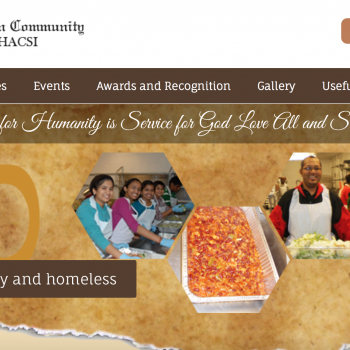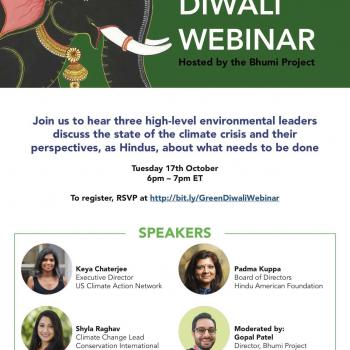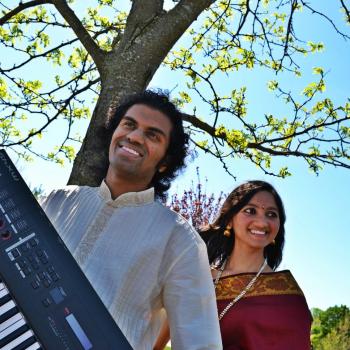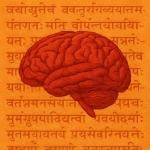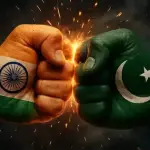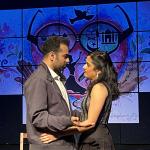An “either or” approach is very black and white and doesn’t easily allow for a colorful, vibrant, or fluid way to raise interfaith children.
In my last essay, I talked about marriage and how, when I think of marriage in the Hindu-American context, it is of interfaith marriage, and especially the future. Just as I am unable to stop at one essay on marriage, KJ Dell’Antonia wrote twice in the New York Times, first about what happens when a Hindu marries a Catholic and the second time about raising interfaith kids. The issues around parenting, raised in both her essays, are critical to why interfaith marriage has the potential to be very challenging for Hindu Americans. Rephrasing the Hindu in Dell’Antonia’s story, “Only after one becomes a parent, does one’s spiritual self matter to anyone else.”
Most Hindus raised in America are the product of a spiritual tradition that is as much cultural as it is religious. Hinduism is largely linked to ethnic identity, and practices of different Hindu Americans take on the flavors of the specific sampradaya and regional background of the practitioners. Many of the immigrants who bring Hinduism alive in America do so without ever having lived as a minority and without having had to explain why they practice what they practice. As they parent, they often don’t have the language or understanding necessary to explain to their Hindu American children what it means to be a Hindu, and it can be difficult to illustrate it through experience; a Bengali, a Telugu, a Marathi, a Gujarati (people from some of the different Indian language communities) will each celebrate festivals differently—and sometimes not celebrate the same holiday at all! It can be difficult to provide a shared experience amongst Hindu Americans, so that children can identify a specific activity with being Hindu.
I remember being in a prasad line one Sunday at our local temple, a time when we share a community meal after a religious event. A Board member and I got into a conversation about what makes someone Hindu. The discussion was difficult, and the question complex; in fact, Belgian scholar Koenraad Elst wrote a book that attempts to answer “Who is a Hindu?” In this book, titled Who Is a Hindu?: Hindu Revivalist Views of Animism, Buddhism, Sikhism, and Other Offshoots of Hinduism, the author also compares Hinduism to monotheistic religions such as Christianity.
And perhaps that is where the story of the couple in Dell’Antonia’s anecdote, and other interfaith couples like them, comes in. Hindus in India learn to be Hindu almost by osmosis, whereas Hindu Americans don’t always have to answer what it means to be a Hindu until they teach their children about their faith and find ways to practice it. They live in a country where the educational system often portrays their beliefs unjustly, as exotic, and even with ridicule, making it difficult to recognize their tradition. It can even lead to a situation where children, possibly struggling with typical immigrant and cultural identity issues, refuse to identify as Hindu, with an outright rejection of the ancient faith of their ancestors.
Hindu Americans live in a country where the majority faith is Christianity, and most people are monotheistic. But Hinduism is not simply a monotheistic faith. My father taught me that, as a Hindu, one must simply follow and fulfill one’s dharma, whether as a polytheist, monotheist, or atheist. My life’s journey has been to discover my dharma, and practice it. But my life’s journey has also given me the opportunity to live both in America, where I am one of the Hindu minority, and in India, where I am one of the Hindu majority. And it is to India I turn to explain the challenges I face as a Hindu in America, ones that can also impact how interfaith children are raised in America.
The FABC PAPERS is a project of the Federation of Asian Bishops’ Conferences (FABC), “designed to bring the thinking of Asian experts to a wider audience and to develop critical analysis of the problems facing the Church in Asia from people.” In a paper on Religious Freedom in the Context of Asia, the challenge of practicing an Eastern faith tradition in a Western country is brought out: “[T]he Asian approach to truth [is a] conjunctive that says ‘both and’ in contrast to the disjunctive Western approach that affirms ‘either or’.” According to the authors, “The former is flexible, tolerant and open to dialogue whereas the latter is prone to intolerance and resistant to dialogue.”
I know that this explanation of the “both and” Eastern approach is what set me on the course of interfaith activism, but it is the work of another set of scholars who provide a response to how I contend with the “either or.” In their book, American Grace: How Religion Divides and Unites Us, authors Robert D. Putnam and David E. Campbell attempt to answer this question: “How can religious pluralism coexist with religious polarization?” Through many anecdotes and much research, they respond that the answer lies in the fact that religion in America is highly fluid, and interfaith tolerance and acceptance of diversity are increasing.
While such sweeping statements as the FABC one on the difference between Eastern and Western approaches to Truth are difficult to stomach, one must acknowledge that an “either or” approach is very black and white and doesn’t easily allow for a colorful, vibrant, or fluid way to raise interfaith children. It is perhaps fortunate that “P.” (the Hindu in the interfaith marriage in the NYT story) is encouraged to “celebrate everything, respect everything, believe what feels right.” P., like me, will have to find and fulfill her dharma in raising kids—interfaith, Hindu-American, whatever. They are our future.


